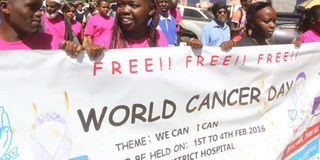Radiotherapy machine spells new dawn for cancer patients

Pupils mark World Cancer Day on February 4, 2016 in Eldoret town. The disease is still one of the top killer diseases in the country. PHOTO | JARED NYATAYA | NATION MEDIA GROUP
What you need to know:
- In 2010, the International Atomic Energy Agency said Kenya was one of the several African countries that lacked a strategy and policies to address cancer diagnosis.
- Cancer is the third major cause of death among Kenyans after pneumonia and malaria according to the 2016 Economic Survey.
- Poor communication has been known to affect a patient’s adherence to treatment, an increase in fear over their condition and poor response to treatment.
As the world marks Cancer Day today, 11-year-old Fredrick Otieno watches forlornly as his friends play hide-and-seek, his favourite game, without him.
Fredrick is suffering from Leukemia.
He and his nine siblings depend on the small business that his parents run in Mukuru kwa Nyayo Estate.
It hardly puts enough food on the table, let alone meet costs for the specialised treatment Fredrick needs.
Mr Jared Onyimbo watches as his son, once active, wasting away, consumed by the disease.
“I don’t know what to do. All the family can do is pray,” he says.
Fredrick and other poor cancer patients are condemned to a life of pain and misery, a situation worsened by the ongoing doctors’ strike.
The main public hospitals that offer cancer treatment at subsidised rates are now closed.
In 2010, the International Atomic Energy Agency said Kenya was one of the several African countries that lacked a strategy and policies to address cancer diagnosis, pathology, palliative care and training of specialists.
Through partnerships and deliberate efforts, some of the challenges that placed Kenya in that position, are being addressed.
For instance, the Sh300 million cancer machine Indian Prime Minister Narendra Modi donated to the Kenyatta National Hospital in July last year is already in the country.
The Cobalt and simulator radiotherapy machine - commonly referred to as Bhabhatron II - arrived in the country in November last year, after a two-month delay.
RADIOTHERAPY MACHINE
Head of Kenyatta National Hospital cancer department Dr Eliud Njuguna in December said that the importation of second machine was in progress after the radiation protection board issued an importation license for the radio active part of the machine.
The Cobalt Radiotherapy Unit, to be procured from Indian company Panacea Biotec, will mark a new dawn for patients who have for years endured long waits for treatment at the country’s biggest referral hospital.
Patients have had to look for other treatment options when the only two machines at KNH broke down.
Apart from shortening the queues at KNH, the machine will reduce the horrible side effects that come with the radiation that destroys the healthy tissue around the parts where the cancerous cells are.
It will change cancer treatment as it would kill cancer cells by targeting them through “pinpoint therapy” without damaging surrounding tissue.
This type of treatment is different from the old one where tissues surrounding the tumour were also damaged.
The machine will also treat more patients compared to the current machines.
It targets to treat 40 to 50 patients daily and was expected to be installed this month.
During Mr Modi’s visit, Kenya also signed a multi-billion-shilling deal with India to build East Africa’s largest cancer hospital at KNH next year.
It is expected to ease pressure on the referral hospital.
Cancer is the third major cause of death among Kenyans after pneumonia and malaria according to the 2016 Economic Survey — with about 60 deaths daily — with most Kenyans diagnosed late due to ignorance; 80 per cent of cancers are diagnosed at an incurable stage.

A cancer patient prepares to undergo radiotherapy at Kenyatta National Hospital on March 23, 2015. The Cobalt Radiotherapy Unit will change cancer treatment as it would kill cancer cells by targeting them through “pinpoint therapy”. PHOTO | EVANS HABIL | NATION MEDIA GROUP
BUILDING TRUST
It is for this reason that the Ministry of Health partnered with the Kenya Network of Cancer Organizations, and the American Cancer Society to develop cancer information materials — in English and Kiswahili — in a bid to debunk myths particularly among cancer patients, their families and their caregivers.
It explains that cancer is the uncontrolled growth and spread of cells.
It can affect almost any part of the body. The growth often invades surrounding tissue and can spread to other areas.
The material also includes how health workers should communicate to cancer patients about their diagnosis.
Health Cabinet Secretary Cleopa Mailu, who launched the documents in Nairobi, said the materials will be instrumental in empowering patients and build a trusting relationship between them and health care team for better outcomes.
He said: “A diagnosis of cancer is a turbulent moment for individuals and their families and requires structured and well-articulated communication.”
Poor communication has been known to affect a patient’s adherence to treatment, an increase in fear over their condition and poor response to treatment.
The World Health Organisation (WHO) notes the soaring cancer cases is due to an ageing population and the increasing adoption of risk behaviours such as consumption of unhealthy diets, lack of physical exercise, and harmful use of alcohol and tobacco use.
FOOD TOXINS
In Meru County, in addition to the above causes cancers in the region stem from the exposure to aflatoxin in maize.
Meru deputy director of agriculture Misheck Kaburu has warned that the fungal toxin levels are ‘alarming’.
Exposure to aflatoxins is associated with an increased risk of liver cancer.
The odourless, invisible poison is produced by certain moulds in soil and grains.
Last year more than 15 percent of patients seeking radiotherapy treatment at Kenyatta National Hospital then, were from Meru.
Reporting by David Muchui, Eunice Kilonzo and Elizabeth Merab




